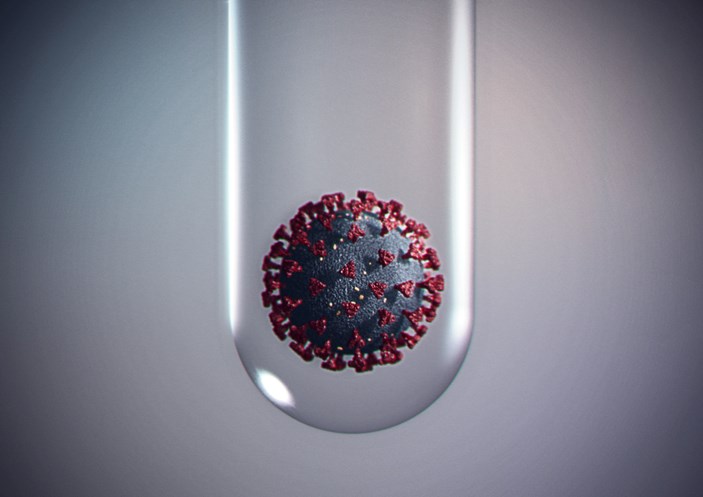Let’s be honest: there are many ways in which size matters, and for some purposes small is beautiful. However, sometimes very small things, like nanoparticles, are misunderstood.
In recent months, many people have had difficult conversations with friends and family members who were hesitant about taking the COVID-19 vaccine. In some cases, this hesitance arose because they have been led to believe that . It is lipid nanoparticles — called liposomes — that in the COVID-19 mRNA vaccines.
The nanoparticles in mRNA vaccines
Those to where it can interact with the immune system and trigger the production of antibodies. Their small size allows them to do that job faster and more effectively.
Liposomes are minuscule droplets of fat that mimic the membranes of our cells. This allows the particles to not only travel to their destination in the body without triggering an immune reaction, but also to fuse with our cells that can then uptake the mRNA molecule and synthesize the protein for which it codes. Once delivery is complete, these lipid nanoparticles are degraded by our body just like any other lipid.
This technology has been made possible through years of concerted efforts by the scientific community. These types of nanoparticles are a potentially useful vehicle for all sorts of other medicines. These include , and also .
As scientists who make nanoparticles, we had hoped that at least our loved ones would be less fearful of our work. Thankfully, they are all now fully vaccinated, but vaccine hesitancy stemming from the novelty of the terms nanoparticles and nanotechnology leaves us concerned.
With the rise of COVID cases due to the Omicron variant, efforts to address vaccine hesitancy across the globe need to be ramped up, including information about nanoparticles. The terms nanoparticles and nanotechnology may be uncommon to a lot of people, but humans have been interacting with nanoparticles for millennia, and each one of us comes into contact with nanotechnology-based products every single day.
Nanoparticles
One of the authors — Keroles Riad — mass-produces nanoparticles by literally (very satisfying). This process — called flame spray pyrolysis — can produce special nanoparticles called , which are used in lithium batteries and gas-sensing devices. But nanotechnology has uses in every aspect of our lives, affecting things like our wine, our guts and our climate.
The nanoparticles in mRNA vaccines are not the first nanoparticles used for health applications. For instance, co-author Sylvie Ouellette is currently synthesizing lipid nanodiscs . This consists of breaking down the lipid layer of E. coli bacteria into small pieces, to study the proteins it contains as if they were still in their natural environment. Since these proteins are involved in antibiotic resistance, lipid nanodiscs are an important tool in the fight against infection.
Sylvie has also studied to assess their usefulness in diagnosing and treating cancer and other health conditions.
Nanoparticles have been used for centuries. In fourth century China, .
Gold nanoparticles have been at the core of , for thousands of years. Although the jury is still out as to whether these gold nanoparticles in and of themselves confer healing properties, the method by which they are synthesized has paved the way for their use in modern medicine. They are now studied as a vehicle .
How small is a nanometer?
“Nano” comes from a .” In essence, it means “very small.” A nanometer is 70,000 times smaller than the thickness of a human hair. A nanoparticle is anything that is so small that its size ranges from one to a few hundred nanometers. If you cut a block of wood to pieces that are about 0.0000001 centimetres (one nanometer), you will have made nanoparticles.
Nanoparticles can be made out of almost anything, from metals to fat. They can form naturally or inadvertently, and can also be synthesized in research or industrial laboratories.

Perhaps one of the most common nanoparticles today is , which is used to reinforce our car tires and improve their wear resistance, . We with titanium white nanoparticles. The pills we swallow to treat our headaches or serious illnesses are usually with silica or titanium nanoparticles.
More recently, several brands of anti-aging creams have boasted higher efficacy thanks to their — the same type of nano-sized fat particles that are at the core of the mRNA COVID vaccines.
Given the broad incidence and wide variety of nanoparticles, there are also some that are not beneficial. For example, the that smokers inhale are very harmful to the lungs.
Other types of soot nanoparticles enter the atmosphere when planes and cargo ships burn fuel, where they are the third major contributor to the climate crisis. However, unlike other greenhouse gases, (compared to a hundred years in the case of carbon dioxide). That means that if we were to stop emitting soot today, the benefits would be immediate.
Small is good when used beneficially, but nanoparticles can sometimes trigger fear or mistrust. Just like the conversations we’ve had with our own families, helping people understand how nanoparticles are part of our everyday lives may help dissolve some of those fears.
Do you have a question about COVID-19 vaccines? Email us at [email protected] and vaccine experts will answer questions in upcoming articles.
The authors do not work for, consult, own shares in or receive funding from any company or organization that would benefit from this article, and have disclosed no relevant affiliations beyond their academic appointment.

